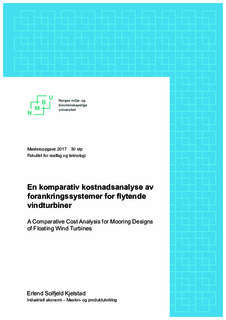| dc.contributor.advisor | Nygaard, Tor Anders | |
| dc.contributor.author | Kjelstad, Erlend Solfjeld | |
| dc.date.accessioned | 2017-11-06T14:13:30Z | |
| dc.date.available | 2017-11-06T14:13:30Z | |
| dc.date.issued | 2017 | |
| dc.identifier.uri | http://hdl.handle.net/11250/2464324 | |
| dc.description.abstract | I denne oppgaven har jeg gjort en analyse av kostnadene forbundet med fire ulike forankringskonsepter av OOStar Wind Floater. De følgende konseptene er:
• Baseline (147 mm)
• Klumpvekt (100 tonn)
• Doble liner (76 mm)
• Parallell fiberline (165 mm polyester)
Mitt inntrykk av bransjen er at kostnadsestimater ofte er basert på beregninger kun basert på kjettingens vekt. Kostnadsbildet er langt mer komplisert enn dette og jeg har derfor valgt å se på hele forankringens konfigurasjon fra anker til innfesting. Med denne oppgaven ønsker jeg å gi et mer nyansert bilde på hva kostnadene består av.
For å danne grunnlag for en kostnadsanalyse har jeg først valgt å gjøre en verdistrømsanalyse av forankringsprosessen. Analysen er gjort på bakgrunn av samtaler og møter med Statoil, Technip FMC, DNV GL, Dr.techn. Olav Olsen samt flere underleverandører.
Underveis i oppgaven har jeg utviklet et program i Excel som er brukt for å beregne netto nåverdi og energikostnad (LCOE) basert på verdistrømmene fra verdistrømsanalysen. I tillegg er det gjort en følsomhetsanalyse av diskonteringsraten, valutakursen og kostnadslikhet mellom Baseline og Klumpvekt.
Funnene i analysen viser at produksjonskostnadene utgjør over 80 % av det totale kostnadsbildet. Av produksjonskostnadene er det kjettingen som utgjør mesteparten. Der fiber kan erstatte deler av kjettingen vil det gi et betydelig utslag på totalkostnaden.
Bruk av sugeankere gir markant høyere kostnader i både produksjon og installasjon. Det anbefales ikke å ekskludere det fra videre analyser fordi muligheten for å plassere dem i et mer lønnsomt nettverk bør studeres.
Både Klumpvekter og Doble liner var de rimeligste konseptene for både produksjon og installasjon og oppnådde 22 % lavere netto nåverdi enn Baseline. | nb_NO |
| dc.description.abstract | I have through this thesis conducted a cost analysis of four different mooring concepts for the OOStar Wind Floater. The chosen concepts are:
• Baseline (147 mm)
• Clump Weight (100 tonn)
• Doubled Lines (76 mm)
• Fiberline in parallell (165 mm polyester)
My impression of the industry is that cost estimates are often done by calculating the price from the weight of the chain only. I believe that the whole picture is more complicated and I have therefore chosen to examine the entire mooring system from anchor to fixing the lines on the platform. In this way I have tried to create a more nuanced picture of the real costs associated with mooring systems.
To develop a good foundation before conducting the cost analysis I did a value stream mapping of the mooring process. The value stream mapping is based on discussions and meetings with Statoil, Technip FMC, DNV GL, Dr.techn. Olav Olsen among other smaller actors.
During the work I have developed a program through Excel which takes all the costs from production and operations and calculate the energy cost (LCOE) and net present value. The program is also used for running a sensitivity test of the discount rate, currency rate and the cost parity between Baseline and Clump Weight.
My findings show that the factor influencing the total costs in the most significant way are production costs with a share of more than 80 %. The largest share of production costs have I found to be the use of chain. If fiber ropes can replace chain, even in short parts, it will make considerable differences on the total cost.
The use of suction anchors is also shown to play a significant role on the total cost. It would, however, not be encouraged to exclude suction anchors from further studies. One possibility could be to examine whether the suction anchor has an effect in a network, when shared by several wind turbines.
My analysis shows that the most cost efficient concepts are Clump Weight and Double Lines. Of all four concepts they achieved the lowest cost on both production and installation and a net present value 22 % below Baseline. | nb_NO |
| dc.language.iso | nob | nb_NO |
| dc.publisher | Norwegian University of Life Sciences, Ås | nb_NO |
| dc.rights | Attribution-NonCommercial-NoDerivatives 4.0 Internasjonal | * |
| dc.rights.uri | http://creativecommons.org/licenses/by-nc-nd/4.0/deed.no | * |
| dc.subject | Verdistrømsanalyse | nb_NO |
| dc.subject | Flytende vindturbiner | nb_NO |
| dc.title | En komparativ kostnadsanalyse av forankringssystemer for flytende vindturbiner | nb_NO |
| dc.title.alternative | A comparative cost analysis for mooring designs of floating wind turbines | nb_NO |
| dc.type | Master thesis | nb_NO |
| dc.description.version | submittedVersion | nb_NO |
| dc.subject.nsi | VDP::Technology: 500::Industrial and product design: 640 | nb_NO |
| dc.source.pagenumber | 77 | nb_NO |
| dc.description.localcode | M-IØ | nb_NO |

